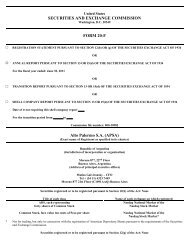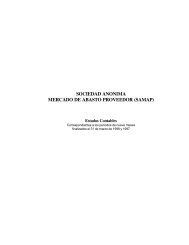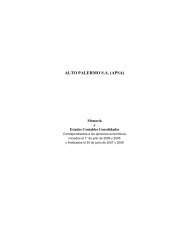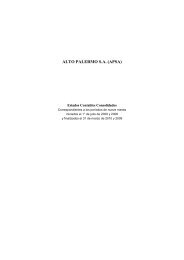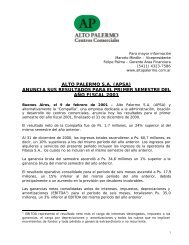- Page 1 and 2:
United States SECURITIES AND EXCHAN
- Page 3 and 4:
Table of Contents ALTO PALERMO S.A.
- Page 5 and 6:
(d) Selling Shareholders...........
- Page 7 and 8:
DISCLOSURE REGARDING FORWARD-LOOKIN
- Page 9 and 10:
differences between the tax basis a
- Page 11 and 12:
CPCECABA issued revised accounting
- Page 13 and 14:
As of and for the year ended June 3
- Page 15 and 16:
Exchange Rates In April 1991, Argen
- Page 17 and 18:
stabilized. However, inflationary p
- Page 19 and 20:
Additional controls could have a ne
- Page 21 and 22:
located. All of our shopping center
- Page 23 and 24:
Our ability to grow will be limited
- Page 25 and 26:
We are subject to great competitive
- Page 27 and 28:
• adverse changes in the regional
- Page 29 and 30:
Due to the currency mismatches betw
- Page 31 and 32:
ITEM 4. Information on the Company
- Page 33 and 34:
During fiscal year 2007 we had capi
- Page 35 and 36:
company primarily engaged in the ac
- Page 37 and 38:
(3) We have a 85% equity interest i
- Page 39 and 40:
Alto Palermo.......................
- Page 41 and 42:
Tenant mix of Abasto The following
- Page 43 and 44:
The following table describes Alto
- Page 45 and 46:
Alto Avellaneda’s five largest te
- Page 47 and 48:
Buenos Aires Design, City of Buenos
- Page 49 and 50:
Lease expirations for Buenos Aires
- Page 51 and 52:
Revenues from admission rights (2)
- Page 53 and 54:
following periods: Revenues: 53 Fis
- Page 55 and 56:
Type of Business Gross Leasable Are
- Page 57 and 58:
Tenant Type of Business Gross Lease
- Page 59 and 60:
The following table sets forth cert
- Page 61 and 62:
Residential Complexes Torres de Aba
- Page 63 and 64:
We manage and operate each of the s
- Page 65 and 66:
Related Business Credit Card Operat
- Page 67 and 68:
The table below sets forth informat
- Page 69 and 70:
Portfolio Status 69 As of June 30,
- Page 71 and 72:
71 As of June 30, 2005 2006 2007 (i
- Page 73 and 74:
Company Shopping Center Location (1
- Page 75 and 76:
Company Shopping Center Location (1
- Page 77 and 78:
Ps.200,000 and 90 percent of purcha
- Page 79 and 80:
On February 4, 2003, the Executive
- Page 81 and 82:
ecognized professional organization
- Page 83 and 84:
(1) We own a 100% interest in Empal
- Page 85 and 86:
The following Operating and Financi
- Page 87 and 88:
Impairment of long-lived assets As
- Page 89 and 90:
notes (the "Convertible Notes") in
- Page 91 and 92:
abolished the fixed parity between
- Page 93 and 94:
A general description of each segme
- Page 95 and 96:
As of and for the year ended June 3
- Page 97 and 98:
Operating Results Fiscal Year 2007
- Page 99 and 100:
Gross Profit Due to the factors abo
- Page 101 and 102:
Credit Card Operations. Selling exp
- Page 103 and 104:
2006 to a net loss of Ps.19.5 milli
- Page 105 and 106:
consequence of the sale of the Alco
- Page 107 and 108:
elated to the increase of our reven
- Page 109 and 110:
from the same segment. Operating in
- Page 111 and 112:
Revenues increased 60.7%, from Ps.
- Page 113 and 114:
fiscal year ended June 30, 2005. Th
- Page 115 and 116:
to the previous period. Other. Admi
- Page 117 and 118:
majority of which is held by our ma
- Page 119 and 120:
Fiscal Year 2006. The net cash used
- Page 121 and 122:
Convertible Notes due 2014 On Augus
- Page 123 and 124:
Neuquén Project. On September 20,
- Page 125 and 126:
advertising campaigns at the nation
- Page 127 and 128:
of Banco Hipotecario, E-Commerce La
- Page 129 and 130:
Puerto Retiro S.A., Tarshop S.A. an
- Page 131 and 132:
Name Date of birth Position 131 Cur
- Page 133 and 134:
Audit Committee In accordance with
- Page 135 and 136:
conditions were left unchanged. The
- Page 137 and 138:
B. Related Party Transactions Lease
- Page 139 and 140:
The Convertible Notes originally ma
- Page 141 and 142:
the shopping center. On August 15,
- Page 143 and 144:
Year declared Cash dividends Stock
- Page 145 and 146:
Fiscal Year 2005 Buenos Aires Stock
- Page 147 and 148:
MERVAL The MERVAL is a corporation
- Page 149 and 150:
August 28, 2087. Article 4 of our b
- Page 151 and 152:
supervisory committee; • dividend
- Page 153 and 154:
A shareholder who votes on a matter
- Page 155 and 156:
NASDAQ Standards for U.S. companies
- Page 157 and 158:
NASDAQ Standards for U.S. companies
- Page 159 and 160:
• Argentine individuals and compa
- Page 161 and 162:
has to be made with the resulting p
- Page 163 and 164:
• a dealer in securities or curre
- Page 165 and 166:
• are obligated to make payments
- Page 167 and 168:
of holding the shares or ADS if we
- Page 169 and 170:
Minimum Presumed Income Tax (Impues
- Page 171 and 172:
Interest Rate Risk Our exposure to
- Page 173 and 174:
expenses in Ps. 0,3 million annuall
- Page 175 and 176:
ITEM 12. Description of Securities
- Page 177 and 178:
engagements, such as the review of
- Page 179 and 180:
Santander Río S.A. as Registrar, P
- Page 181 and 182:
Alto Palermo S.A. (APSA) Index to C
- Page 183 and 184:
ASSETS Alto Palermo S.A. (APSA) Con
- Page 185 and 186:
Alto Palermo S.A. (APSA) Consolidat
- Page 187 and 188:
Supplemental cash flow information
- Page 189 and 190:
Alto Palermo S.A. (APSA) Notes to t
- Page 191 and 192:
Alto Palermo S.A. (APSA) Notes to t
- Page 193 and 194: Alto Palermo S.A. (APSA) Notes to t
- Page 195 and 196: 3. Significant accounting policies
- Page 197 and 198: 3. Significant accounting policies
- Page 199 and 200: 3. Significant accounting policies
- Page 201 and 202: 3. Significant accounting policies
- Page 203 and 204: 4. Breakdown of the main captions a
- Page 205 and 206: Alto Palermo S.A. (APSA) Notes to t
- Page 207 and 208: Alto Palermo S.A. (APSA) Notes to t
- Page 209 and 210: Alto Palermo S.A. (APSA) Notes to t
- Page 211 and 212: 5. Shareholders' equity a. Common s
- Page 213 and 214: Alto Palermo S.A. (APSA) Notes to t
- Page 215 and 216: Alto Palermo S.A. (APSA) Notes to t
- Page 217 and 218: 9. Segment information General info
- Page 219 and 220: 9. Segment information (continued)
- Page 221 and 222: Assets 10. Additional information o
- Page 223 and 224: 13. Earnings per share Alto Palermo
- Page 225 and 226: Alto Palermo S.A. (APSA) Notes to t
- Page 227 and 228: 18. Subsequent events (continued) T
- Page 229 and 230: Alto Palermo S.A. (APSA) Notes to t
- Page 231 and 232: Alto Palermo S.A. (APSA) Notes to t
- Page 233 and 234: Alto Palermo S.A. (APSA) Notes to t
- Page 235 and 236: Alto Palermo S.A. (APSA) Notes to t
- Page 237 and 238: Alto Palermo S.A. (APSA) Notes to t
- Page 239 and 240: Alto Palermo S.A. (APSA) Notes to t
- Page 241 and 242: Alto Palermo S.A. (APSA) Notes to t
- Page 243: Alto Palermo S.A. (APSA) Notes to t
- Page 247 and 248: Alto Palermo S.A. (APSA) Notes to t
- Page 249 and 250: Alto Palermo S.A. (APSA) Notes to t
- Page 251 and 252: Alto Palermo S.A. (APSA) Notes to t
- Page 253 and 254: Alto Palermo S.A. (APSA) Notes to t
- Page 255 and 256: Alto Palermo S.A. (APSA) Notes to t
- Page 257 and 258: Alto Palermo S.A. (APSA) Notes to t
- Page 259 and 260: Alto Palermo S.A. (APSA) Notes to t
- Page 261 and 262: Alto Palermo S.A. (APSA) Notes to t
- Page 263 and 264: Properties: Principal account 20. O
- Page 265 and 266: 20. Other financial statement infor
- Page 267 and 268: Alto Palermo S.A. (APSA) Notes to t
- Page 269 and 270: 20. Other financial statement infor
- Page 271 and 272: DOCUMENT 25,257,215 - Florida 537 -
- Page 273 and 274: -----------------------------------
- Page 275 and 276: U.S. Trust Indenture Act Section Ce
- Page 277 and 278: Note: This reconciliation and tie s
- Page 279 and 280: Table of Contents (Continued) ARTIC
- Page 281 and 282: Table of Contents (Continued) Secti
- Page 283 and 284: convertible, at any time, at the op
- Page 285 and 286: “Argentine GAAP ” has the meani
- Page 287 and 288: Settlement Date”); provided furth
- Page 289 and 290: the date of such determination (the
- Page 291 and 292: agreement executed in connection wi
- Page 293 and 294: include any principal or other amou
- Page 295 and 296:
“Payment Date” means, with resp
- Page 297 and 298:
“Rating Agency” means any one o
- Page 299 and 300:
custodian for DTC, and registered i
- Page 301 and 302:
(1) the then outstanding aggregate
- Page 303 and 304:
permitted by applicable law, the Se
- Page 305 and 306:
available funds to the Trustee, for
- Page 307 and 308:
(7) the right or obligation, if any
- Page 309 and 310:
NEWYORK 6033603 v8 (2K) 27
- Page 311 and 312:
the principal amount of Securities
- Page 313 and 314:
NEWYORK 6033603 v8 (2K) 30
- Page 315 and 316:
authenticate and deliver or cause t
- Page 317 and 318:
nothing herein shall prevent APSA,
- Page 319 and 320:
The Trustee or Transfer Agents shal
- Page 321 and 322:
payment, transfer or exchange, in a
- Page 323 and 324:
pursuant to this Section 3.4(b) or
- Page 325 and 326:
fiduciary or partnership or limited
- Page 327 and 328:
NEWYORK 6033603 v8 (2K) 43
- Page 329 and 330:
Section 3.12. Other Information. Fo
- Page 331 and 332:
(h) Indebtedness arising from the h
- Page 333 and 334:
(in integral multiples of US$1,000)
- Page 335 and 336:
accordance with the terms thereof,
- Page 337 and 338:
and payable on any such Security fo
- Page 339 and 340:
Section 4.6. Limitations on Suits b
- Page 341 and 342:
Section 4.9. Control by Securityhol
- Page 343 and 344:
(4) none of the provisions containe
- Page 345 and 346:
compensation of a trustee of an exp
- Page 347 and 348:
NEWYORK 6033603 v8 (2K) 61
- Page 349 and 350:
predecessor Trustee shall apply onl
- Page 351 and 352:
governing the exercise of the right
- Page 353 and 354:
irrevocable once given and will be
- Page 355 and 356:
and the names and addresses of Hold
- Page 357 and 358:
therein, shall not, however, in any
- Page 359 and 360:
Section 8.1. APSA May Consolidate,
- Page 361 and 362:
egistration of transfer, exchange a
- Page 363 and 364:
If less than all the Securities of
- Page 365 and 366:
shall be entitled to accept such ce
- Page 367 and 368:
Section 3(a)(2) of the Securities A
- Page 369 and 370:
(k) APSA shall have paid the Truste
- Page 371 and 372:
sufficiently given or made, for all
- Page 373 and 374:
Any certificate or opinion of any i
- Page 375 and 376:
NEWYORK 6033603 v8 (2K) 88
- Page 377 and 378:
IN WITNESS WHEREOF, the parties her
- Page 379 and 380:
Exhibit A Page 2 THAT IT WILL NOTIF
- Page 381 and 382:
and Conditions ”) and the terms a
- Page 383 and 384:
Exhibit A Page 6 IN WITNESS WHEREOF
- Page 385 and 386:
Date NEWYORK 6033603 v8 (2K) Princi
- Page 387 and 388:
Exhibit B Page 2 THE FOREGOING LEGE
- Page 389 and 390:
As used herein, the term “Holder
- Page 391 and 392:
NEWYORK 6033603 v8 (2K) [ATTACH TER
- Page 393 and 394:
transfers unto FORM OF TRANSFER [In
- Page 395 and 396:
FORM OF REVERSE OF SECURITIES—TER
- Page 397 and 398:
Interest Rate General Exhibit C Pag
- Page 399 and 400:
Exhibit C Page 5 Currency amounts u
- Page 401 and 402:
Exhibit C Page 6 respect to such In
- Page 403 and 404:
Exhibit C Page 8 Interest Reset Dat
- Page 405 and 406:
NEWYORK 6033603 v8 (2K) 9
- Page 407 and 408:
Exhibit C Page 11 Additional Amount
- Page 409 and 410:
Exhibit D Page 2 (4) the additional
- Page 411 and 412:
(3)no directed selling efforts have
- Page 413 and 414:
Exhibit F Page 2 This certificate a
- Page 415 and 416:
(iv) THE PARTIES have entrusted Del
- Page 417 and 418:
Alto Palermo S.A. (APSA)-----------
- Page 419 and 420:
Insurance -------------------------
- Page 421 and 422:
I, Alejandro G. Elsztain, certify t
- Page 423 and 424:
EXHIBIT 13.1 CERTIFICATION OF CHIEF



